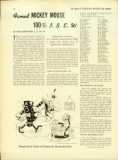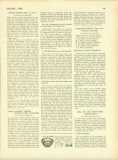The tremendous popularity of the Walt Disney's feature length productions has made possible the realization of his long cherished dream, a brand new studio plant filled with all the gadgets and equipment his fertile mind has been able to devise. It is a regular little city with paved streets, curbs, lights, fire department, theatre, animation building, large sound stages, restaurants and sports facilities. Visitors at the old Disney Studio commented that the artists seemed to be eating all the time, but the new spic and span restaurants on this lot are so inviting that a Hollywood diet is impossible.
The famed multi-plane camera which helps give these new color cartoons a third dimension is said to weigh many tons. This ponderous mechanism is entirely electrically controlled in precise synchonism with a two-direction control board that would delight the eye of any electrical worker. From this giant camera requiring a great building to house it there is another extreme in equipment running so smoothly that shafts only 1/32 of an inch in diameter have appropriate ball bearings working with loss friction than the jewels of a volt-meter. The air must be maintained at the correct temperature and humidity and this is done with a very large electrically-driven air-conditioning system. This equipment was installed by I. B. E. W. members and is now operated by air-conditioning engineer members of Studio Local No. 40. So capable are these members that the studio could not select the best man as foreman so is rotating each one for a six weeks' period as chief to see if one can be chosen.
LARGE CONSTRUCTION JOB
The electrical work required 65 men for about a year working under a special agreement with the Walt Disney management at the regular studio scale. The men were furnished through the cooperation of the Hollywood Studio Local No. 40 and the Glendale Local No. 691, Disney's chief engineer was William E. Garity and the steward was Al Peck.
The members on the job were:
| B. H. Ackerman | Carl LaFors |
| Leo Baltazar | R. C. Lunsford |
| Dick Boyd | Glen McKenzie |
| Don Cornwall | L B. Nelson |
| Frank Druce | Dick Pocket |
| Al Derby | A. O. Peterson |
| Steve Harrington | Joe Lifton |
| Al Henry | Barney Shifton |
| C. W. Hulick | S. G. Smith |
| T J Jones | B. S. Torkelson |
| Walt. Kenney | W. T. Wood |
| Jack Ladd | Fred Wilson |
| M. H. Mayhew | M. F. Baker |
| H. Michaelis | J. L. Barnes |
| Bill Newlove | C. Bradley |
| C. U. Penney | Bill Daniells |
| L. K. Romberger | Bill Davenport |
| R. Schott | M. T. Gardiner |
| Sidney Skoog | Charles C. Heintz |
| Walt Stanley | Ralph Hickerson |
| Ed Wescott | A. Isaacson |
| Charles Waldriff | Jack Keener |
| Eddie Arimond | Birt Blackman |
| Dave Barnett | Gordon Lyons |
| A. Butterworth | Bill Morris |
| Vic Bongberg | Frank McDonald |
| D. Dornall | Al Peck |
| E. W. Hale | Sam Powell |
| Bobby Heer | George Rinner |
| D. K. Henry | John Stone |
| Fred Hurley | J. B. Stansell |
| George Kling | Harold Vaught |
| Cordon Williams |
So startlingly new were the devices installed that many of them had to be developed as the work progressed. As patents and trade secrets were involved much of the work was of a confidential nature, yet our men produced work that is regarded as the ultimate around the studios. Even government men have inspected the equipment to see what real union craftsmen can do when given the opportunity.
HOW MICKEYS ARK MADE
Since the present day cartoon has grown to a full feature length many of our members may be interested in the various steps in making Walt Disney Animated Productions.
The script for a Disney feature resembles that of an ordinary motion picture. Short productions do not resquire a script. Instead the brief plot is laid out in a series of pencil sketches pinned in sequence to a huge board. When a story is satisfactorily worked out by the story crew the board is moved to the rooms of the director assigned to the picture. Any changes are approved by Walt, and the director calls in the musician, layout man, background artists and the animators.
The animator does not begin to draw a sequence of action until the background layouts are finished, and the dialogue, sound effects, and music have been recorded. The animator must watch the layouts carefully so that he will not have his characters walk through such objects as trees, fuimiture, or buildings.
SPEECH RECORDED FIRST
After the dialogue track is recorded (on equipment installed and serviced by I. B. E. W. men) it is turned over to the cutting room where it is analyzed and a chart prepared which shows, in terms of single frames of film, the length of each word, the intervals between words, the vowel and consonant sounds, accents, inhalations and exhalations. The animator draws from this pattern. If the character says "Hello,” for example, and the cutting department has indicated that this word, recorded, occupies eight frames of film, the animator must produce eight drawings in sequence in which the lips of the character move to form the word, plus whatever bodily accent may have been decided upon.
When all drawings are completed, given a preliminary photographic test and approved by Walt, they are sent to the Inking and painting department. In this department nearly 200 girls transfer the drawings to transparent celluloid and outline the characters with pen and ink in such a skillful manner that none of the original charm is lost. Other girls apply the chosen colors of paint to the reverse side of the celluloids so that the ink outlines will show. The paints used for the Disney productions are ground and mixed within the studio paint laboratory on special equipment operated electrically and installed and maintained by I. B. E. W. members of Studio Local No, 40. Over 2,000 special formulas covering all colors and shades of paints and inks arc used regularly.
After the celluloids are finished they are sent to the camera department. Each celluloid is placed over the correct background and photographed. Suitable arrangements arce made with the new multiplane camera to give the illusion of depth to the backgrounds. Celluloids can be photographed to produce about 15 feet of film an hour. Even a short requires 700 feet of film and takes about 45,000 drawings. In making a feature picture it is divided up into several sequences which may require as many as six directors with their entire units. After a production is filmed the processes lending up to the finished product are very much like that of any regular motion picture studio. The sequences are put together and previewed for audience reaction. The production may then require further editing, depending on the preview reception, before it is ready for release in final form.
As the loss of the foreign markets has been felt more by Mickey Mouse than some of the other companies, we express the hope that American workmen will enable Walt to employ more of our members through their patronage in the future.

